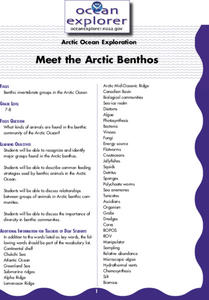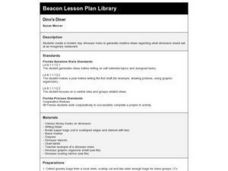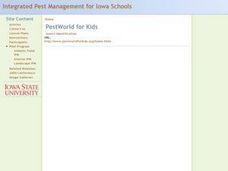Curated OER
Newton's Law of Universal Gravitation
Pupils explore the nature and magnitude of gravitational forces. In this gravitation lesson plan students study gravity and answer questions.
Curated OER
Loss of Wetlands: Subsidence
Students observe subsidence and the effect it has on wetlands with a classroom demonstration. They think about the impact of global warming and the sea level and how it affects the marsh.
Curated OER
Cumulative Effects Assessment - What if?
Tenth graders discuss natural and human influences that may affect the ecological integrity of national parks. They study the concepts environmental assessments. In groups, they research a park's situation and present their findings at a...
Curated OER
Ecosystems
Sixth graders perform various labs, create presentations, and do hands on activities to explore the ecosystem.
Curated OER
Ozone Pollution: Smog Alert
Students simulate the development of smog. They discover how it forms naturally in nature. They read news articles about the ozone and pollution. They discuss what they can do to lower the pollution they generate.
Curated OER
A Tree Full of Ancestors
Students study human evolution and the scientific process. They complete the Origins of Humankind Web activity to become familiar with the hominid species as well as the associated evidence found, in the form of fossils and artifacts.
Curated OER
Elements of Biology: Biomes
Students describe the different types of biomes. In this biology lesson, students create a map of assigned biome with descriptive paragraphs. They share their findings to class.
Curated OER
Evolution Explorations
Students compare characteristics of animals and human beings. In this biology lesson, students observe an animal and record their observations. They infer whether the evolution theory is true or not.
Curated OER
An Underwater Sediment Slide?
Students explore the proximity of the Hudson Shelf Valley and the Hudson Canyon to one of the Nation's most populated areas. They study that from 1987 to 1992, two dumpsites in the Hudson Shelf Valley and Hudson Canyon, one 12 miles
Curated OER
Meet the Arctic Benthos
Students recognize and identify major groups found in the Arctic benthos. They describe common feeding strategies used by benthic animals in the Arctic Ocean. They discuss relationships between
Curated OER
Yo-Yos, Tow-Yos and pH, Oh My!
Learners explore how hydrothermal vents are formed and where they are located on the ocean floor. They study how scientists use CTDs to locate hydrothermal vents.
Curated OER
Dino's Diner
Second graders create a modern day dinosaur menu to generate creative ideas regarding what dinosaurs would eat at an imaginary restaurant. They utilize a graphic organizer imbedded in this plan to guide their menu ideas.
Curated OER
Marine Debris
Students will perform experiments to examine if debris will float, or blow in the wind. They discuss the effects of these characteristics on marine debris.
Curated OER
Life of An Island
Students identify the steps in the life cycle of an island. They label islands in the correct stage of their life cycle and illustrate the process themselves. They also review the concept of plate tectonics.
Curated OER
How Much Radon Is Around You?
Students examine the amount of radon in their home. They discover how it enters the home and how to properly seal off any route that is allowing radon to seep in. They calculate the amount of ventilation needed in their home to be safe.
Curated OER
Particulate Matter: The Lorax
Students collect air samples to test it for air pollution. They are read the story The Lorax and discuss the effects of air pollution. They share their observations with the class.
Curated OER
Making a Mini-Landfill
Students create a mini-version of a landfill. They examine the materials they use everyday and determine if they decompose or not. They identify the materials as renewable or nonrenewable as well.
Curated OER
Environment: Mealworm Observations
Learners observe plant and animal growth and participate in class discussions about the subjects. They also record their observations in a log. Using observation and the scientific method, they describe the characteristics of mealworms.
Curated OER
Atmospheric Pressure
Ninth graders explore the abstract idea of the atom and explain the differences and similarities between solids, liquids, and gases. They understand the molecular differences between solids, liquids, and gases.
Curated OER
Ecology: Trees
Fourth graders research and identify the different layers of the forest. As a class, they observe real-life trees or analyze a poster, and discuss the characteristics of each forest layer. Students then draw a forest and label the...
Curated OER
Forests
Fourth graders examine the impact forests have on our lives. They listen to the book "The Giving Tree" by Shel Silverstein, and brainstorm about how forests are important to us. In small groups they create a poster illustrating how the...
Curated OER
Herd Management
Students examine herd management and career opportunities while working in groups. They analyze herd strengths and weakness as well as identify herd traits and other management factors through research. Individually students present a...
Curated OER
How Big is a Crowd?
Sixth graders compare the relative sizes of the five Great Lakes and their human populations. They describe some of the problems that arise when many people depend on a limited resoure. Students discuss how the Great Lakes and the...
Curated OER
Looking at the World in a Different Light
In this lesson, 7th graders relate colors to wavelengths of light; explain how we see colors and describe types of waves and their technological applications. Students go through a tour and answers questions to the quiz as they go...

























